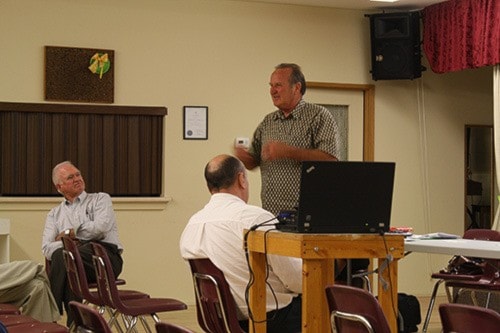Regional district politicians and staff met with approximately 20 members of the Okangan Falls community on May 15 to discuss increasing sewer rates in the village.
Electoral Area “D” Director Tom Siddon provided a history of the old and new sewer plants in Okanagan Falls in an attempt to provide a clear picture to the residents as to why rates were about to hike.
The regional district will be increasing sewer rates over the next three years in order to begin repayment of a 4.9 million dollar loan that was the community’s one third portion of the total cost for the new sewage treatment plant in Okanagan Falls.
Siddon explained that plans for the new water treatment plant began in earnest nine years ago, but were stalled until two thirds funding was found.
“It’s time for the community to pay the balance,” Siddon said, “the cost must be presented to the community.”
RDOS Engineer Liisa Bloomfield discussed the differences in technology between the old and new plants, noting that public consultation played a major role in the final selection of the treatment plant and process.
An additional treatment for water exiting the new plant known as “bio filtration” or “polishing” - where the outflow is passed through marshlands prior to entering the Okanagan River channel - will have to wait until the Canadian Wildlife Service reviews a study on possible “endocrine disruptors” in the outflow water.
The plant is now running in the commission stage. This phase involves the possible temporary use of the old treatment plant while the new one works through any start up issues that might occur as the plant moves towards a fully operational phase. Once that is achieved, the old plant will be decommissioned, and most of the infrastructure will be removed. What remains will serve as a sewage lift station.
RDOS Financial Manager Sandy Croteau presented the bad news - sewage rates will rise over the next three years as the regional district implements the full cost of the loan repayment.
Okanagan Falls’ sewer user rates covers all costs associated with the operation of the sewer system, Croteau explained, adding that the original cost of the new plant was based on a figure of 11.7 million dollars, of which 6.25 million was funded through two thirds funding and a further $518,000 provided through Development Cost Charges and capital reserves.
Annual debt servicing on the 4.9 million dollar loan for an average single family dwelling will be $260, which will be phased in over a three year period. This year’s increment will be $114. She provided an example of an average residential user fee of $616, up $85 over last year. Croteau added that the regional district had monthly payment plan options available.
Croteau noted other unanticipated costs related to the new plant, including environmental monitoring, operational costs, staffing, and utilities. New connections and the possibility of reducing operating costs may help to reduce future increases, Croteau said.
Residents were assured that should future developments and other communities wish to hook up to the system, the new users will pay for any additional costs needed to service them. The plant was built with room for future increases in capacity, but there will be additional capital expenditure associated with a large increase in users.
One resident asked for a sani-dump station to be located in Okanagan Falls, as recreational vehicles have to leave the community to dump their holding tanks. Director Siddon agreed, saying,
“We’ll have to re-examine that.”
Few seemed upset by the upcoming rate increases, which was the major reason for the meeting. One resident commented that a sewer connection was still cheaper than a $30 - $40,000 septic system.
“We wanted people to understand the costs, and their bill when they get it,” Siddon said, “we feel it’s the way to go.”
He added that phasing in the debt portion over three years would be easier on taxpayers, noting that “now is not the time,” for big tax increases.
The need to clean up the valley’s water and Okanagan Falls’ residents reaction to the challenge was highly praised by the regional district politicians in attendance.
Osoyoos Mayor Stu Wells also attended the meeting, addressing the gathering to express his support for the project and the hope that secondary treatment through the Vaseux wetlands would take place soon. Wells’ interest in the project comes from his association with the Okanagan Basin Water Board, in addition to being mayor of a downstream community.
“It’s been said that water in Osoyoos has passed through at least three sets of kidneys,” told the gathering, praising Okanagan Falls residents for taking the initiative and bearing the cost to upgrade and modernized their sewage treatment facitlities.
